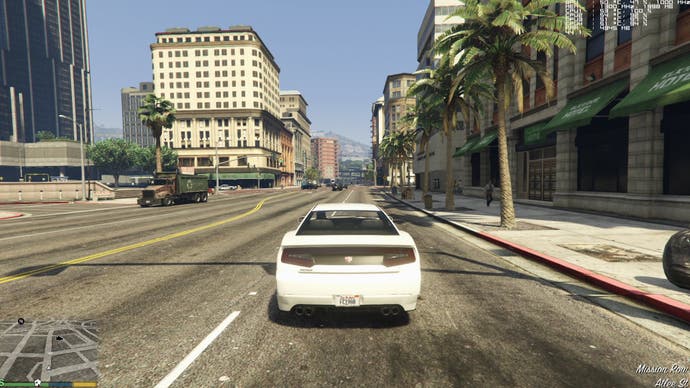What does it take to run GTA 5 at 1080p60?
Digital Foundry on the cost of entry to the best PC experience.
It's finally here. 18 months on from Grand Theft Auto 5's last-gen release, the chance to tour Los Santos at 60fps is now a reality on PC. The PS4 and Xbox One versions may already have the 1920x1080 checkbox ticked, but this PC effort adds a bevy of options to take things further, bringing support for resolutions up to 4K, better effects and broader draw distances. But does it actually run well?
And indeed, what does it take to run GTA 5 at 1920x1080 and 60 frames per second, with a mind to match console graphics settings? To answer this, we've tried it with a selection of graphics cards from each price range. At the lowest end of the spectrum we have Nvidia's circa £100 GTX 750 Ti, joined by AMD's mid-range R9 280 and 290 cards (at £140 and £220 respectively), while at the top we have a GTX 780 Ti at £320. Each is placed into our quad-core Intel i7 4790K machine in turn, itself backed by 16GB RAM and a speedy SSD to house the game's 64GB install.
But four cards slotted into a top-end rig isn't entirely a fair test. Given that this i7 processor alone costs around £270 (mismatching the budget associated with a GTX 750 Ti), as a counterpoint we also have a Core i3 4130 machine - a dual 3.4GHz core processor that costs just £90, also backed by 16GB of memory. In total this gives us four cards, two PCs, and a total of eight combinations to test. But which is the most cost-effective path towards that 1080p60 target?
The GTX 750 Ti is first up, already a plucky contender for best price per pound in its bracket from earlier testing. With Nvidia's day one 350.12 driver locked and loaded, we target high settings across the board. This keeps DirectX 11 features like tessellation and high quality grass in play, while the population and scaling sliders are set to 50 per cent to minimize pop-in. All told, this falls closely in line with the PS4 and Xbox One set-ups, with FXAA engaged, and the 'softer' shadow option selected as a best match. Curiously, and much like the console editions, an off-putting filtering cascade runs across all shadows in the game regardless of setting, and despite having set 16x anisotropic filtering.
| 1920x1080, FXAA, High, 50% distance scaling | GTX 750 Ti (Lowest/Average FPS) | R9 280 (Lowest/Average FPS) |
|---|---|---|
| Core i3 4130 | 42.0 / 59.1 | 34.0 / 61.0 |
| Core i7 4790K | 47.0 / 86.0 | 73.0 / 92.8 |
On the i7 4790K this set-up gets us a perpetual 50-70fps read-out on the 750 Ti, with heavier dips inevitably creeping in around the downtown area. On the high setting for textures and shaders, this puts the RAM budget at an estimated 2024MB out of the card's available 2047MB - only just squeezing past. The good news is that it's very playable right off the bat at 1080p with these settings, but by dropping shadows to normal quality there's enough headroom to nail a perfect lock 60fps on this card.
The situation changes slightly with an i3 4130 CPU. As expected, the move to a dual-core processor clocked at 3.4GHz is an issue for rendering city areas, and driving at pace through busy streets produces bigger dips to 50fps. Our 60fps read-out is steadied a little by paring back draw distances and population density to 20 per cent, but little else helps. Even dropping all settings to 'normal' only claws a few frames per second back for these stress points. Overall, it's not worth the sacrifice to the visuals, and left at high settings the 750 Ti still produces 60fps for the most part, if not the perfect lock we had hoped for.
On the plus side, the GTX 750 Ti fares much better when paired with a budget CPU than the rivalling AMD R9 280. Despite costing £30-40 more, the card is a write-off for 60fps performance at 1080p, even with all settings and sliders at their lowest. Left at high settings, spikes down to 35fps are common, again pointing to an issue with AMD cards when paired with weaker CPUs. Unlike the Nvidia 750 Ti, a 30fps lock is needed here when targeting 1080p and anything close to current-gen console settings.
Switching back to an i7 4790K processor is a night-and-day difference. The R9 280 achieves high settings across the board with aplomb here, and in practice there's enough memory headroom to add very high textures, particles, grass and tessellation, plus 2x MSAA and still cap at a smooth 60fps. This takes up 2.5GB of the card's 3GB pool of GDDR5, though driving up world density to 100 per cent does leech into its overall performance levels, as do post effects. Left at high, the frame-rate is in another category to the 750 Ti tested at the same settings, but an i7 processor is a must.
| 1920x1080, 2x MSAA, Very High, 100% distance scaling | R9 290 (Lowest/Average FPS) | GTX 780 Ti (Lowest/Average FPS) |
|---|---|---|
| Core i3 4130 | 30.0 / 56.2 | 40.0 /63.4 |
| Core i7 4790K | 54.0 / 70.2 | 57.0 / 78.0 |
AMD's 15.4 beta drivers are crucial when playing GTA 5 too. Moving to the R9 290, performance stuttered heavily on the standard Omega 14.12 drivers at first, and as much as 20fps is gained in benchmark tests by updating. With this set, 60fps proves easy for this 290 to hold on an i7 4790K machine, even in tests at very high settings, 2x MSAA and sliders at 100 per cent. Ultra quality post effects are also approachable without a serious penalty. Locking down 60fps at 1080p is sure-fire with the right setting balance on this GPU; an amazing return given its £220 price-tag, and on visual presets beyond the PS4's to boot.
As with its cheaper sibling though, the R9 290 immediately struggles when paired with our i3 4130 CPU. Based on MSI Afterburner's diagnostics, all four of its processor threads run between 90-100 per cent as we drive through Los Santos, each hitting the ceiling in turn. The off-shoot is this: drops below 60fps are a reality for this card regardless of how low we position its graphics settings. It's easier to salvage performance here than with the R9 280 though, simply by dropping presets to high, though our target frame-rate is just not attainable here. It's a surprise twist given the impressive, and very cost-effective, results the R9 290 produces on an i7 machine.
Meanwhile the GTX 780 Ti links up with this budget CPU with fewer issues. The bottlenecks remain around densely packed, physics-affected areas, but 60fps is at least attainable with its population scale dialled down, and effects on high. Rarely do we see a £300+ graphics card being lumped in with a CPU of this calibre though, making this a very hypothetical match-up.
On an i7 system, all bets are off for Nvidia's card. For the 780 Ti it's less of a question of whether 1080p60 is possible, and instead which effects you want bundled in. As with the R9 290 there's leeway to introduce ultra-grade effects here above the 'very high' standard, and even add in advanced menu options like higher quality shadows. All this works at 60fps, though it only just scrapes through the game's RAM barrier, with 3016MB taken of the available 3071MB. Alas, the extended distance scaling bar is a no-go area from here, as each notch asks for an extra chunk of memory that begins to impact performance. It's apparent this is territory for the behemoth GPUs like the Titan X, a welcome option for those with the processing grunt to back it.

On the whole, Grand Theft Auto 5 on PC is a highly adaptable effort that gives most set-ups a fighting chance to run the game. From budget £100 GPUs to £320 enthusiast cards, scalability is excellent across the entire gamut we tested, all of which is aided hugely by the game's range of graphics toggles and sliders. The only hitch is in its engine's reliance on fast, multi-threaded CPUs for AI and physics-related tasks - though this is still better optimised than GTA 4 was on PC.
We'll be dissecting the full extent of the PC's visual strengths over console in a face-off soon, but in terms of performance, there's no denying that Rockstar delivers. Some bugs hold the package back from perfection, however, such as a curious limit to 59Hz output (rather than the 60Hz standard for most monitors), which causes a slight stutter to motion in v-synced gameplay. Issues with its shadow system persist, too. But the results on even budget set-ups still outstrip those on PS4 and Xbox One. The GTX 750 Ti paired with the i3-3410 is a real success, for example - a combo that forms part of a circa-£300 PC, where 1080p60 at high settings is very doable.
As for pushing the boat out with a quad-core i7 machine, the award for best performance per pound goes to the R9 290 on very high settings. At £100 less than Nvidia's GTX 780 Ti, it makes sense to go with AMD in this bracket given the relatively small difference in frame-rate. It must be stressed that the AMD path is only viable if other, top-end components are in place, in particular a strong CPU. But whichever way you turn, the two-pronged attack of 60fps gameplay and superior draw distances on PC makes the 18-month wait worth it.



















